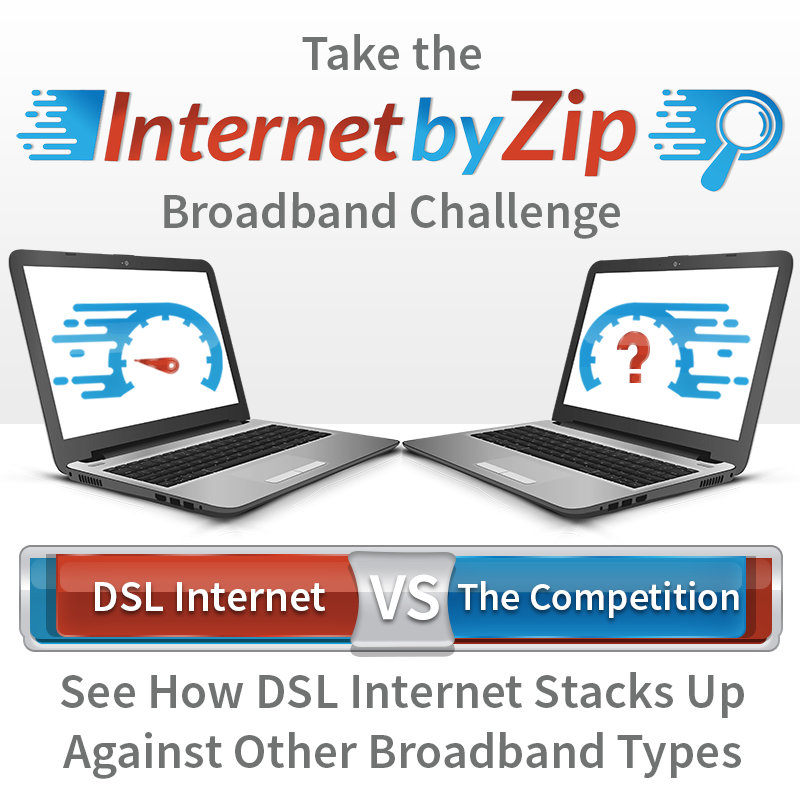
What is DSL Internet?
DSL is an acronym that stands for Digital Subscriber Line. DSL is one of the broadband internet technologies used to provide high-speed internet connections over traditional phone lines provided by the local telephone company, and uses copper or fiber optic wire to connect you to the world wide web. With DSL internet, the signal used for internet service data is sent at a higher frequency than the signal used for telephone service. DSL can send data at a much faster speed than older dial-up internet services used over copper phone lines, so there isn’t as much waiting for files to finish downloading. DSL is much more suited for today’s internet users that are always streaming music, watching video and gaming online.
How DSL Internet Works:
DSL high speed internet service works by sending the information data signal over a telephone companies phone lines at a higher frequency than the voice data signals. Traditional home phone service doesn’t need to use all of the capacity on the telephone wires, so the extra bandwidth can be used for transmitting data, allowing you to use a the same phone line you use for voice service to connect to the internet. A DSL filter is installed on the telephone line to filter out the higher frequency data signals to get rid of the background noise that can accompany voice services. Although DSL broadband internet comes in over a phone companies copper phone line, you can often get standalone DSL internet access in your home with or without a home phone service. DSL without phone service is often referred to as no-dialtone DSL, naked DSL, or dry loop DSL. The availability DSL line without phone service attached may depend on who you have for a DSL provider, as well as your geographical location.
How Fast is DSL Internet?
The DSL speed available at your location can vary wildly due to the nature of DSL being distance limited. That is to say, the farther or more rural your home is from your local telephone company's equipment facilities, the slower the connection will be. Although DSL is distance sensitive, there are areas where DSL high speed internet service is quite fast. DSL download speeds commonly range anywhere from 256 Kbps to 100 Mbps. As technology improves, DSL speeds are getting faster and faster. DSL service capable of Gigabit (1Gbps) speed is now being deployed by some providers, but this technology isn’t available on a wide scale at this time.
DSL Internet Download Speed Examples:
Quick Guide to Common Types of Consumer DSL Internet:
This guide lets you compare the most commonly used types of DSL, as well as their associated speed capabilities:
Quick Guide to DSL Internet VS. Other Types of Internet Service:
This guide lets you compare DSL internet versus other types of broadband internet service. Figuring out which service is faster, or "better" depends on the type of service being considered, as well as the company offering the service. Different companies offering the same type of service (DSL, Cable, Fiber, etc.) can vary wildly in speed and reliablility. Keep this in mind when considering which internet service is best for your household as it's not just the technology type that's important when choosing which internet connection is right for you. This DSL internet comparison guide is based on the technology behind the type of internet service being compared, not individual providers offering DSL internet service.

DSL Internet Pros & Cons:

DSL Internet Pros
DSL Internet Cons
DSL Internet Requirements:
Connecting to the internet via DSL requires a DSL modem and an active subscription to a DSL connection provider. Customers can use the phone and internet connection at the same time over the same line. A DSL filter is installed on the telephone line to filter out the higher frequency data signals to get rid of the background noise that can accompany traditional landline telephone service when both signals come in over the same line. You'll need a network interface card (NIC) or a wireless card in your computer to hook it up to the DSL providers modem.
DSL Internet Questions & Answers:
Answer: - A DSL modem is a networking device that connects your computer/router to the phone line and recieves and sends data in the form of tones and frequency signals. A DSL filter does exactly as the name implies as it filters and blocks frequencies that would interfere with the the DSL connection, while still allowing for the phone line to be simultaneously used for voice calls.
